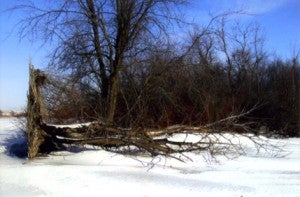Most artists tend to draw in curves, not in straight lines
Published 7:00 am Sunday, February 17, 2013
Column: Art is, by Bev Jackson Cotter
“I’m not an artist. I can’t even draw a straight line.”
How many times have you heard this? How many times have you said it?
A couple of years ago, I noticed a post on the west edge of a tiny island in Bancroft Bay. It stood tall and straight like it had a purpose. I had never noticed it before, and I wondered why.
That island is a small piece of land covered with undergrowth and as far as I know has never housed any cattle (fence post?) or home (electrical post?). There was no reason for a post to be in that spot. Did one of the nearby neighbors put it there?
Then, thanks to my binoculars, I realized that the post was a solid mass of tree roots. The tree had fallen leaving its root base exposed flat and vertical. Those roots had no reason to reach far into the earth for water so they had spread out in a horizontal mass that gave the tree no stability in a strong wind. What unusual lessons nature gives to us.
One day, when the lake ice was frozen solid, I made my way across the bay to examine the tree and its root structure and to take some pictures of it before it decays and becomes a part of the island soil. It’s an amazing example of the circle of life, and it makes me wonder about our own emotional and family roots. How far down do they go? What stability do they give us? But I wander from my theme…
Esther Dendel’s book, “Designing from Nature” provides a delightful description of the designs nature gives us. She says, “Straight lines belong to railroad tracks, skyscrapers, superhighways across the prairies, windowpanes, rulers and a thousand other objects in a technical society. Most hospitals and schools are laid out on a grid. The child is born, goes to school, grows up and works in a factory laid out on a grid. When he finally dies, he is taken over by city streets laid out in squares and buried in a cemetery, again laid out on a grid.
“Man has dominated his world with straight-line efficiencies, including straightened riverbeds. Art provides a way to get off the grid for those who have tired of it. Unless one is designing for machine production, one can indulge what seems a natural preference for the curvilinear. It is difficult to imagine oneself weeping tears shaped like cubes.”
She goes on to describe natural curved designs from the bark of a birch tree, grease pooling in a frying pan, the design in a flower petal and hundreds of other curvilinear natural shapes.
I love old architecture. I am fascinated by Gothic windows in churches. Victorian trim on houses, the rounded, chipped shape of landscaping blocks and ornate cornices on business buildings in historic districts. I find it interesting that today people are softening their ranch homes with ornate, rounded front porch railings.
Does an artist need to know how to draw a straight line? Yes, occasionally, and a ruler can satisfy that need. But mostly an artist draws curves. Dendel mentions the banana where parallel lines converge at the tips, crescent shapes like fat little new moons. She goes on to describe the fruits and vegetables she finds on a shopping trip.
“I go to the market looking for lines. From force of habit I take a grocery cart. Man-made, it is an assembly of metal grids. As I wheel it before me down the aisle, I suddenly see how incongruous it is among the fresh fruits and vegetables. I recall other markets, markets in remote African villages, markets in Span and in Yugoslavia, where all the shoppers carry beautiful, bulging baskets, curved to conform with the fruits of the earth… I wheel the cart back to its nested fellows.”
If I were to draw the downed tree with its tangled mass of vertical roots, I could not use a ruler. There is not one straight line in that entire circle of tangled roots.
May I suggest to you, try drawing curvy lines and see what happens. You might be surprised.
Bev Jackson Cotter is a member of the Albert Lea Art Center where the Annual All Member Show is on exhibit. Art center members are also currently showing their work at the Austin Art Center in Oak Park Mall. The elementary and secondary student art will be on display in March. Watch for more information on this exhibit.


